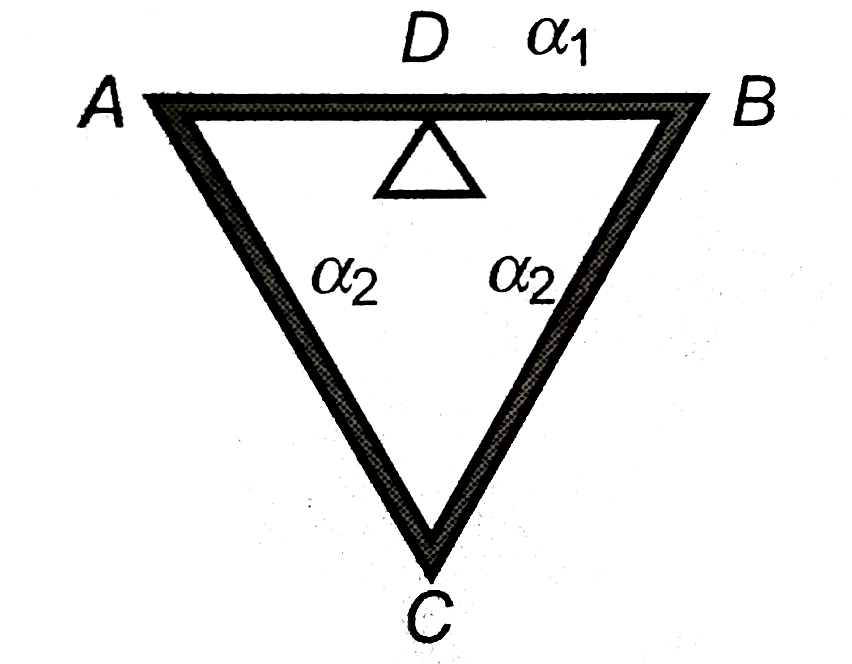Three rods AB, BC and CA identical in shape and size are hinged together to form an equilateral triangle. Rods AB and CA have coefficient of linear expansion α1=12×10−6/°C, while that of rod BC is α2=18×10−6/°C. What should be the rise in temperature of the system of rods, so that the angle opposite to the rod BC increases by an amount 0.02°?

150√327°C
100√327°C
250π√327°C
100π√327°C
The correct Answer is:C
Topper's Solved these Questions
- THERMAL PROPERTIES OF MATTERBOOK - AAKASH SERIESCHAPTER - THERMAL PROPERTIES OF MATTEREXERCISE - ADDITIONAL PRACTICE EXERCISE (LEVEL - II) PRACTICE SHEET (ADVANCED) Straight Objective Type Questions (Expansion of Liquids :)
6 Videos
- THERMAL PROPERTIES OF MATTERBOOK - AAKASH SERIESCHAPTER - THERMAL PROPERTIES OF MATTEREXERCISE - ADDITIONAL PRACTICE EXERCISE (LEVEL - II) PRACTICE SHEET (ADVANCED) Straight Objective Type Questions (Expansion of Gases & KTG :)
9 Videos
- THERMAL PROPERTIES OF MATTERBOOK - AAKASH SERIESCHAPTER - THERMAL PROPERTIES OF MATTEREXERCISE - ADDITIONAL PRACTICE EXERCISE (LEVEL - II) PRACTICE SHEET (ADVANCED) Straight Objective Type Questions (Thermometry:)
8 Videos
- SYSTEM OF PARTICLES AND ROTATIONAL MOTIONBOOK - AAKASH SERIESCHAPTER - SYSTEM OF PARTICLES AND ROTATIONAL MOTIONEXERCISE - PRACTICE EXERCISE
99 Videos
- THERMODYNAMICSBOOK - AAKASH SERIESCHAPTER - THERMODYNAMICSEXERCISE - EXERCISE - 3
33 Videos
Similar Questions
Three rods A,B and C having indentical shape and size, are hingerd together at ends to form an equilateral triangle. Rods A and B are made of same material having coefficient of linea thermal expansion α1 while that of material of rod C is α2. By how many kelvin should the system of rods be heated to increase the angle opposite to rod C by Δθ.
View SolutionThree rods of equal of length are joined to from an equilateral triangle ABC. D is the midpoint of AB. The coefficient of linear expansion is α1 for AB and α2 for AC and BC . If the distance DC remains constant for small changes in temperature,

View Solution
Knowledge Check
The coefficient of linear expansion of a metal rod is 12×10−6/0C, its value in per ^(0)F
A203×10−6/0FB154×10−6/0FC21.6×10−6/0FD12×10−6/0FThree rods of equal of length are joined to from an equilateral triangle ABC. D is the midpoint of AB. The coefficient of linear expansion is α1 for AB and α2 for AC and BC . If the distance DC remains constant for small changes in temperature,
 Aα1=α2Bα1=2α2Cα1=4α2Dα1=1/2α2
Aα1=α2Bα1=2α2Cα1=4α2Dα1=1/2α2A rod is fixed between two points at 20∘C. The coefficient of linear expansion of material of rod is 1.1×10−5/.C and Young's modulus is 1.2×1011N/m. Find the stress develop in the rod if temperature of rod becomes 10∘C
A1.32×107N/m2B1.10×1015N/m2C1.32×108N/m2D1.10×106N/m2
When a metal rod is heated through 30∘C the thermal strain in the rod is 3.6×10−4 .what is the coefficient of linear expansion of the metal ?
View SolutionBy how much amount should the temperature of a steel rod be increased so that its length increases by 0.5%? The coefficient of linear expansion of steel is 1.2×10−5C−1
View SolutionA uniform metal rod is used as a bar pendulum. If the room temperature rises by 10∘C, and the coefficient of linear expansion of the metal of the rod is 2×10−6per∘C, the period of the pendulum will have percentage increase of
View SolutionA uniform metal rod is used as a bar pendulum. If the room temperature rises by 10∘C, and the coefficient of linear expansion of the metal of the rod is 2×10−6per∘C, the period of the pendulum will have percentage increase of
View SolutionAt temperature T, length of rod is L. If coefficient linear expansion of material of rod is 2×10−2/.∘C then length of rod when temperature of rod increased by 25∘C is
View Solution
